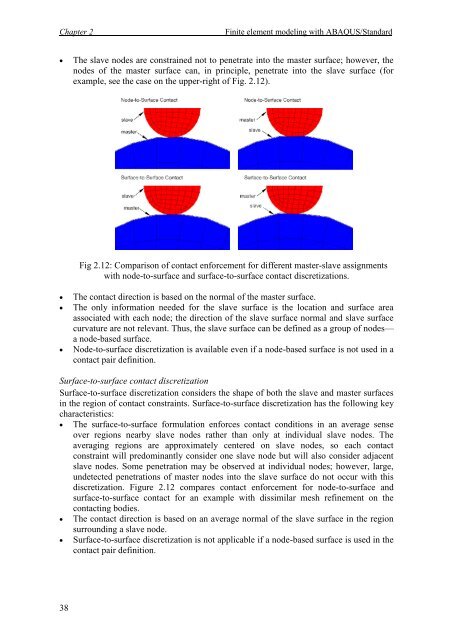Nonlinear Static and Dynamic Analysis of Steel Structures with ...
Nonlinear Static and Dynamic Analysis of Steel Structures with ...
Nonlinear Static and Dynamic Analysis of Steel Structures with ...
You also want an ePaper? Increase the reach of your titles
YUMPU automatically turns print PDFs into web optimized ePapers that Google loves.
Chapter 2 Finite element modeling <strong>with</strong> ABAQUS/St<strong>and</strong>ard<br />
The slave nodes are constrained not to penetrate into the master surface; however, the<br />
nodes <strong>of</strong> the master surface can, in principle, penetrate into the slave surface (for<br />
example, see the case on the upper-right <strong>of</strong> Fig. 2.12).<br />
38<br />
Fig 2.12: Comparison <strong>of</strong> contact enforcement for different master-slave assignments<br />
<strong>with</strong> node-to-surface <strong>and</strong> surface-to-surface contact discretizations.<br />
The contact direction is based on the normal <strong>of</strong> the master surface.<br />
The only information needed for the slave surface is the location <strong>and</strong> surface area<br />
associated <strong>with</strong> each node; the direction <strong>of</strong> the slave surface normal <strong>and</strong> slave surface<br />
curvature are not relevant. Thus, the slave surface can be defined as a group <strong>of</strong> nodes—<br />
a node-based surface.<br />
Node-to-surface discretization is available even if a node-based surface is not used in a<br />
contact pair definition.<br />
Surface-to-surface contact discretization<br />
Surface-to-surface discretization considers the shape <strong>of</strong> both the slave <strong>and</strong> master surfaces<br />
in the region <strong>of</strong> contact constraints. Surface-to-surface discretization has the following key<br />
characteristics:<br />
The surface-to-surface formulation enforces contact conditions in an average sense<br />
over regions nearby slave nodes rather than only at individual slave nodes. The<br />
averaging regions are approximately centered on slave nodes, so each contact<br />
constraint will predominantly consider one slave node but will also consider adjacent<br />
slave nodes. Some penetration may be observed at individual nodes; however, large,<br />
undetected penetrations <strong>of</strong> master nodes into the slave surface do not occur <strong>with</strong> this<br />
discretization. Figure 2.12 compares contact enforcement for node-to-surface <strong>and</strong><br />
surface-to-surface contact for an example <strong>with</strong> dissimilar mesh refinement on the<br />
contacting bodies.<br />
The contact direction is based on an average normal <strong>of</strong> the slave surface in the region<br />
surrounding a slave node.<br />
Surface-to-surface discretization is not applicable if a node-based surface is used in the<br />
contact pair definition.

















